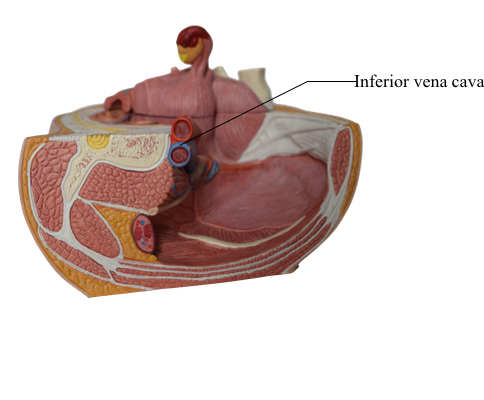Main Model

31 Inferior vena cava

The veins of the posterior abdominal wall are tributaries of the inferior vena cava (IVC), except for the left testicular or ovarian vein, which enters the left renal vein instead of entering the inferior vena cava (IVC). The inferior vena cava (IVC), the largest vein in the body, has no valves except for a variable, non-functional one at its orifice in the right atrium of the heart. The inferior vena cava (IVC) returns poorly oxygenated blood from the lower limbs, most of the back, the abdominal walls, and the abdominopelvic viscera. Blood from the abdominal viscera passes through the portal venous system and the liver before entering the inferior vena cava (IVC) via the hepatic veins.
The inferior vena cava (IVC) begins anterior to the L5 vertebra by the union of the common iliac veins. The union occurs approximately 2.5 cm to the right of the median plane, inferior to the aortic bifurcation and posterior to the proximal part of the right common iliac artery. The inferior vena cava (IVC) ascends on the right side of the bodies of the L3-L5 vertebrae and on the right psoas major to the right of the aorta. The inferior vena cava (IVC) leaves the abdomen by passing through the caval opening in the diaphragm and enters the thorax at the T8 vertebral level. Because it is formed one vertebral level inferior to the aortic bifurcation, and traverses the diaphragm four vertebral levels superior to the aortic hiatus, the overall length of the inferior vena cava (IVC) is 7 cm greater than that of the abdominal aorta, although most of the additional length is intrahepatic. The inferior vena cava (IVC) collects poorly oxygenated blood from the lower limbs and non-portal blood from the abdomen and pelvis. Almost all the blood from the gastrointestinal tract is collected by the hepatic portal system and passes through the hepatic veins to the inferior vena cava (IVC).
The tributaries of the inferior vena cava (IVC) correspond to the paired visceral and parietal branches of the abdominal aorta. The veins that correspond to the unpaired visceral branches of the aorta are instead tributaries of the hepatic portal vein. The blood they carry does ultimately enter the inferior vena cava (IVC) via the hepatic veins, after traversing the liver.
The branches corresponding to the paired visceral branches of the abdominal aorta include the right suprarenal vein, the right and left renal veins, and the right gonadal (testicular or ovarian) vein. The left suprarenal and gonadal veins drain indirectly into the inferior vena cava (IVC) because they are tributaries of the left renal vein.
Paired parietal branches of the inferior vena cava (IVC) include the inferior phrenic veins, the 3rd (L3) and 4th (L4) lumbar veins, and the common iliac veins. The ascending lumbar and azygos veins connect the inferior vena cava (IVC) and superior vena cava (SVC), either directly or indirectly providing collateral pathways.